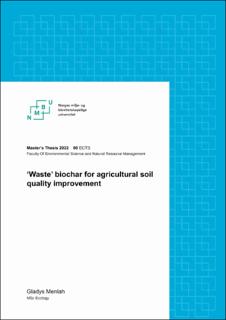| dc.description.abstract | Biochar is a carbonaceous substance obtained from the pyrolysis of biomass under anoxic conditions. The use of biochar dates as far back as the ancient Amazonian times i.e, ‘Terra Preta de Indio’ where dark soils had more fertility compared to normal soils. The interest in biochar in recent years have increased due to its numerous benefits such as its ability to improve soil conditions in particularly tropical regions (it has minimal impact in boreal soils with high soil organic matter) remediate contaminated soils, purify water, etc.
In this study biochar made from four different feedstocks were investigated for their chemical suitability for agriculture use. These feedstocks were clean wood chips (CWC), waste wood (WT), digested sludge from MOVAR wastewater treatment plant (MOVAR) and digested sludge from Lindum waste handling company (DSL), all made at four different pyrolysis temperatures 500oC, 600oC, 700oC and 800oC (or 750oC).
To test the suitability of these biochar for agriculture use, the concentrations of main elements ( Ca, Fe, K, Mg, Na, P, S, Si ) and trace elements (As, Ba, Cd, Co, Cr, Cu, Mo, Ni, Pb, Sr, V and Zn) in all biochar were measured. A method development was carried out to enable biochar to be leached at a fixed pH because no suitable methodology was found after extensive literature review. To approximate the leachable concentrations of main and trace elements in the biochar when applied to soils with different pHs, a batch leaching test was carried out on all biochar at 4 different target pHs: ambient, 7.0, 5.5 and 4.0.
Concentrations of P and K (main elements) in the biochar investigated were far less than those found in commercial fertilizers. Some trace elements concentrations (As, Cu, Cr, Ni, Pb, Cd and Zn) in the biochar were above acceptable limits when compared with EBC (European Biochar Certificate) Agro and Agro Organic limits; though increasing pyrolysis temperature was able to reduce some trace elements, Cd and Pb, to acceptable limits. Concentrations of Cr were also above threshold limits in all biochar when compared with appropriate ‘class’ of the European Union (EU) Fertilizer Framework Directive.
Cu and Zn concentrations in leachate were particularly high for DSL, MOVAR and WT (except WT-600, WT-700, WT-800) when leachate concentrations of trace elements were compared with leachate concentrations from reference biochar, CWC. WT biochar had the most trace elements with concentrations higher than acceptable limits when leachate trace element concentrations were compared with threshold limits from waste deposited to ‘inert landfills’ in Norway.
In accordance with the EU’s Fertilizer framework Directive and EBC standards, these biochar are currently not suitable for agricultural soil improvement purposes due to the high concentrations of trace elements, particularly As, Cu, Cr, and Zn. However further investigations as to how to reduce these trace elements could change the current stance. | en_US |

